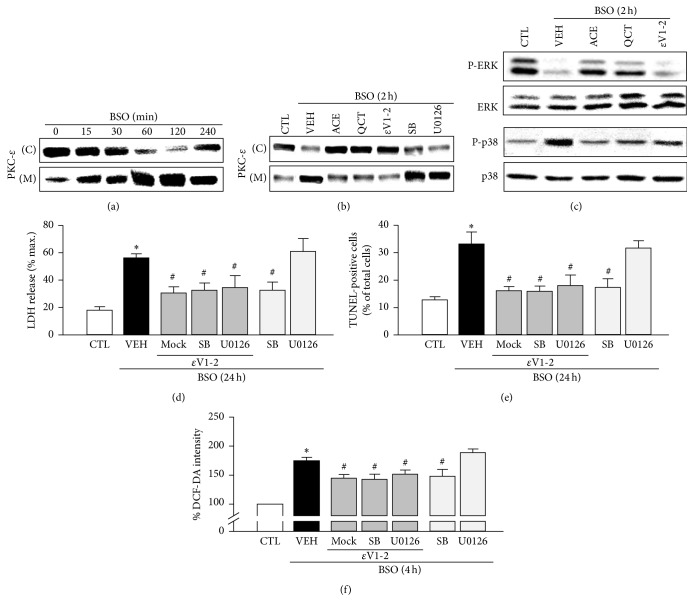Figure 4.
Role of protein kinase C (PKC)-ε in the neuroprotective effects of the Allium cepa extract (ACE) and quercetin (QCT) against L-buthionine sulfoximine- (BSO-) induced cell death in cortical cells. (a) Western blot analysis of PKC-ε in cytosol (C) and membrane fractions (M) of cortical cells exposed to 10 mM BSO for the indicated treatment periods (0–4 h). (b) Representative Western blots of PKC-ε in the cytosolic and membrane fractions after treatment with 10 mM BSO for 2 h in the presence or absence of ACE (10 mg/mL), QCT (10 μM), εV1-2 (5 μM), SB (10 μM), and U0126 (10 μM). (c) Representative Western blots of ERK1/2 and p38MAPK after treatment with 10 mM BSO for 2 h in the presence or absence of ACE (10 mg/mL), QCT (10 μM), and εV1-2 (5 μM). (d) Cortical cells were treated with 10 mM BSO for 24 h in the presence or absence of εV1-2 (5 μM), SB (10 μM), or U0126 (10 μM). Lactate dehydrogenase (LDH) release was measured after a 24 h BSO treatment. (e) The number of terminal deoxynucleotidyl transferase dUTP nick end labeling- (TUNEL-) positive (%) cells was calculated by dividing the number of TUNEL-stained cells by the total number of cells after a 24 h BSO treatment. (f) Reactive oxygen species (ROS) generation was quantified during BSO treatment after cells were pretreated with 10 mM BSO for 4 h in the presence or absence of εV1-2 (5 μM), SB (10 μM), or U0126 (10 μM). ROS levels in cells were quantified by measuring DCF-DA fluorescence intensity and are represented as a percentage (%) of the control (CTL). All data are mean ± standard error (n = 4). ∗ p < 0.05 versus 0 time; # p < 0.05 versus VEH.

